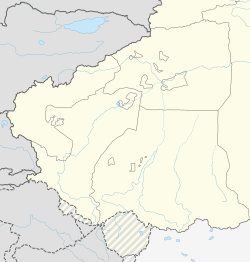
Back Wuqia Xian CEB Ulugqat German Κομητεία Ουλουγκτσάτ Greek Ulugqat Spanish شهرستان اولوغچات FA Xian d'Ulugqat French Contea di Wuqia Italian ウルグチャト県 Japanese 우차현 Korean Улуу-Чат KY
Ulugqat County
Ulughchat, Ulugh Chat, Wuqia | |
|---|---|
 Ulugqat County (red) within Kizilsu Prefecture (yellow) and Xinjiang | |
| Coordinates (Ulugqat County government): 39°43′09″N 75°15′33″E / 39.7191°N 75.2592°E | |
| Country | China |
| Autonomous region | Xinjiang |
| Autonomous prefecture | Kizilsu |
| County seat | Ulugqat (Wuqia) |
| Area | |
• Total | 19,118 km2 (7,382 sq mi) |
| Population (2020)[1] | |
• Total | 60,912 |
| • Density | 3.2/km2 (8.3/sq mi) |
| Time zone | UTC+8 (China Standard Time[a]) |
| Area code | 653024 |
| Website | www |
| Ulugqat County | |||||||||||
|---|---|---|---|---|---|---|---|---|---|---|---|
| Chinese name | |||||||||||
| Simplified Chinese | 乌恰县 | ||||||||||
| Traditional Chinese | 烏恰縣 | ||||||||||
| |||||||||||
| Alternative Chinese name | |||||||||||
| Simplified Chinese | 乌鲁克恰提县 | ||||||||||
| Traditional Chinese | 烏魯克恰提縣 | ||||||||||
| |||||||||||
| Uyghur name | |||||||||||
| Uyghur | ئۇلۇغچات ناھىيىسى | ||||||||||
| |||||||||||
| Kyrgyz name | |||||||||||
| Kyrgyz | ۇلۇۇچات وودانى Улуучат ооданы Uluuçat oodanı | ||||||||||
Ulugqat County[2][3][4][5] (also known as Ulughchat County[6][7] and Wuqia County;[6] Chinese: 乌恰县; pinyin: Wūqià Xiàn) is a county in Xinjiang Uygur Autonomous Region, China. It is under the administration of the Kyrgyz autonomous prefecture of Kizilsu. The county has two towns, nine townships and one state-owned farm, eight communities and 34 villages under its jurisdiction in 2017, its county seat is Wuqia Town. It contains an area of 19,118.11 km2 (7,381.54 sq mi) and has a population of 56,633 (as of 2017) with main ethnic groups of Kyrgyz, Han and Uyghur peoples.
Wuqia County is one of the two westernmost counties in China. It borders with Artux City to the east, Kashgar City to the south, Akto County to the southwest and the Kyrgyz Republic to the northwest. There are two national-level ports of Turugart (吐尔尕特口岸) and Arkaxtam (伊尔克什坦口岸), which are the link between Central and Western Asia and the bridgehead of opening up to the outside world. The county has harsh natural conditions, dry climate, earthquakes, floods, snow storms, sandstorms and other frequent natural disasters. From 1905 to the present, there have been 56 recorded earthquakes with a major earthquake of magnitude 6.0 Mw or above, and more than 20,000 earthquakes of magnitude below 6.0 Mw .
There are 11 local ethnic groups in the county, such as Kyrgyz, Han, Uyghur, Hui, Uzbek, Tajik, etc. and the Kyrgyz ethnic group accounts for about 80% of the total population of the county. Its total land area of the county is 19,118 square kilometers with an average elevation of 2,890 meters and its county seat is at 2,200 meters above sea level. Of which, mountains, Gobi and wasteland account for 99.8% of the total area; the total area of desert grassland is more than 10,667 square kilometers, arable land is 23,000 mu (1,533 hectares), per capita arable land is less than 0.5 mu (333 square meters). It is a typical plateau animal husbandry county with traditional animal husbandry as the main county.[8]
- ^ Xinjiang: Prefectures, Cities, Districts and Counties
- ^ Ministry of Housing and Urban-Rural Development (2010). 建筑抗震设计规范 [GB50011-2010: Code for Seismic Design of Buildings] (in English and Simplified Chinese). Beijing: China Architecture & Building Press. p. 203 – via Google Books.
Ulugqat County
- ^ Cite error: The named reference
earthquake2008was invoked but never defined (see the help page). - ^ Xiao-ying Chen; Yusupjan Setiwaldi; Yisilayin Osman (October 2016). "Epidemiological Studies on Echinococcosis in Kizilsu Kirgiz Autonomous Prefecture of Xinjiang". 中国寄生虫学与寄生虫病杂志. 34 (5): 409–13. PMID 30130008.
Sixty-two villages were selected as investigation spots from 19 towns in agricultural and pasturing areas of Ulugqat County, Artux City, Akto County, and Akqi County during 2011-2012.{...}The morbidity(1.1%) was highest in Ulugqat County and the antibody positive rate(4.9%) in children was highest in Artux City.
- ^ Mei Xinyu. "Gas Trade for the Better". Beijing Review. Archived from the original on 26 July 2015.
Line D of the China-Central Asia gas pipeline network starts from Galkynys Gas Field of Turkmenistan, passes through Uzbekistan, Tajikistan and Kyrgyzstan, and enters China via the Ulugqat County in the south of Xinjiang Uygur Autonomous Region.
- ^ a b "Full Text: Employment and Labor Rights in Xinjiang". China Daily. 17 September 2020. Archived from the original on 27 September 2020. Retrieved 20 October 2020.
from Wuqia (Ulughchat) County, Kizilsu Kirgiz Autonomous Prefecture,{...}from Boritokay Township, Wuqia (Ulughchat) County, Kizilsu Kirgiz Autonomous Prefecture
- ^ "Table 1: List of Government Bids Related to Re-Education Facilities". Jamestown Foundation. Archived from the original on 20 August 2018. Retrieved 22 October 2020.
Ulughchat County, Kizilsu Prefecture
- ^ 乌恰县概况. xjwqx.gov.cn. 2018-05-09. Retrieved 2019-10-24.
Cite error: There are <ref group=lower-alpha> tags or {{efn}} templates on this page, but the references will not show without a {{reflist|group=lower-alpha}} template or {{notelist}} template (see the help page).


